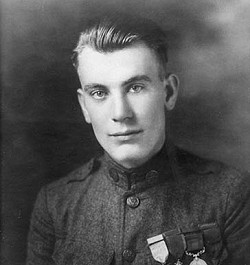|
|
 |
|
|
 |

Thomas Pope, at the age of 22, after the award of the Medal of Honor. Courtesy of Doug Sterner - HomeofHeroes.com.
|
Thomas Pope was
born in Chicago (Illinois) on December 15th, 1894. On July 4th, 1918, he
is a corporal of E Company, 131st regiment of infantry, American Expeditionary
Forces. His company is one of the four companies of the 33rd division involved
at Hamel. Because of his bravery, he is awarded the biggest American military
distinction: the "Medal of Honor". He is even the first one to receive
this medal during the Great War. Here is the corresponding quotation:
"His company was advancing behind the tanks when it was halted by hostile machinegun fire. Going forward alone, he rushed a machinegun nest, killed several of the crew with his bayonet, and, standing astride his gun, held off the others until reinforcements arrived and captured them. ". This act of bravery must be replaced in the context of the battle. In fact, Pope becomes famous during a counter-attack which answers an initial German counter-attack. On July 4th, at about 10 p.m., thus long after the capture of the village of Hamel and the surrounding enemy positions, a powerful German bombardment falls on Wolfsberg. It covers an assault of a party of German bombers supported by about 200 infantry men. These men belong to reserve battalions of the 201st and 202nd Regiment of infantry. They are taking advantage of their former communication or support trenches. The Australians have to abandon a part of their positions. Finally, the Germans manage to establish on approximately 200 yards of trenches between two Australian companies. The two Australian companies organize a counter-attack to regain the lost ground which has to be simultaneously made by the North and by the South. Units of the 44th and the 43rd battalion are being organized in the dark. The Germans shell with mustard and phosgene gas. Some Americans join the Australians. Among them, the platoon of corporal Joliet. The attack is launched at 2 a.m. Assailants charge in the dark and fight with grenade, advancing shelter by shelter, bay by bay. The Germans eventually give up the whole position, some running away over the open or being caught. |
 |
According to
C.W. Bean, Pope would have become famous during this attack in approximately
the way described by the quotation. The Australian historian just mentions
Pope and thus seems little informed about what took place. Strangely, the
other historic sources on the battle do not mention Pope. We can wonder
about the reason why he was granted such a prestigious American decoration.
We could also wonder about the conditions of its allocation.
|

King Georges V awarding medals to the men of the 33rd Div. who became famous on July 4th - it is not Pope on the photo (US official war photographs©).
|
There is some
incoherence. The quotation mentions tanks while these were already removed
from the front. Also, according to an American official history, it is
the company G of the 132nd regiment which participates in the counter-attack.
It is not the company E, that of Pope, who is attached to the 44th battalion.
Perhaps this last one volunteered with Joliet. All this, of course, does
not challenge Thomas Pope's courage. Moreover, for the same action, the
British decorate him with the Distinguished Conduct Medal and the citation
match better with reality (see below). Pope and Joliet are a part of the
19 Americans (5 officers and 14 privates) decorated personally by King
Georges V at Molliens-au-bois on August 12th for their bravery during the
battle. Joliet received Military Medal.
|

The famous "Medal of Honor". |
Sources and links:
- C. E.W. Bean, Official History
of Australia in the War of 1914-1918, p315-317
|
- Military.com
- Medalofhonor.com - Chicago Tribune -ArlingtonCemetery.net -HomeOfHeroes.com -33rd US Division |

33rd US Division badge. |